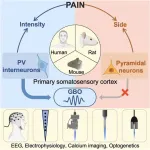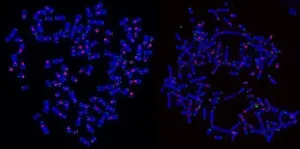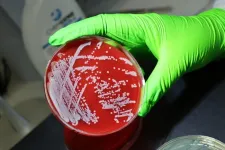(Press-News.org) HOUSTON ― Smokers undergoing lung cancer screening may have the best chance of quitting if they receive integrated care, which includes medication and comprehensive counseling with tobacco treatment specialists, according to researchers at The University of Texas MD Anderson Cancer Center.
The study results, published today in JAMA Internal Medicine, demonstrated that integrated care outperformed other cessation methods with a nearly two-fold improvement in the odds of quitting. In this randomized clinical trial of 630 current smokers who were eligible for lung cancer screening, over 30% of those who received integrated care were still abstaining from smoking after six months.
"For those who smoke, lung cancer screening presents a critical opportunity for us to support them in quitting," said principal investigator Paul Cinciripini, Ph.D., chair of Behavioral Science and executive director of the Tobacco Research and Treatment Program at MD Anderson. "Our study demonstrates that providing access to effective medications and trained tobacco cessation specialists offers the greatest chance at successfully quitting and, hopefully, avoiding the potential of lung cancer.”
Lung cancer is the leading cause of cancer mortality in the U.S. and the second most diagnosed cancer, accounting for one in five cancer-related deaths. Tobacco use is responsible for 85% of lung cancer cases and contributes to nearly 30% of all cancer-related deaths. Each year, an estimated 480,000 Americans die from tobacco-related illnesses.
The average smoker makes several attempts to quit before successfully beating the addiction. MD Anderson’s Tobacco Research and Treatment Program tackles the barriers to cessation at an individual and population level, and its scientists conduct research designed to change clinical practice by addressing knowledge gaps among health care providers treating tobacco addiction.
In this study, participants were recruited from Houston between July 2017-2021. They were at least 50 years old and smoked a median of 20 cigarettes per day. The participants were randomized into three groups of 210, receiving the following interventions: a quitline referral and nicotine replacement therapy (NRT) (QL); a quitline referral plus NRT or medication prescribed by a lung cancer screening clinician (QL+); or integrated care (IC), which included NRT or prescription pharmacotherapy and counseling, provided by a team of tobacco treatment specialists and physicians.
At the three-month mark, IC had the highest quit rate, 37.1%, compared to 27.1% in the QL+ and 25.2% in the QL cohorts. At the six-month mark, IC maintained the highest quit rate, 32.4%, compared to 27.6% for the QL+ group and 20.5% for the QL group.
"Facilities equipped to provide dedicated and integrated care should prioritize doing so to offer patients the best opportunity for smoking cessation and improved health outcomes," Cinciripini said. "Given our results, it is conceivable that this approach could also be highly effective outside a screening environment, such as post-traumatic stress clinics and among patients with cancer, cardiovascular disease or diabetes."
Limitations of this study include that the population was predominately white, and that the entire sample lacked CO (expired carbon monoxide) abstinence verification due to covid restrictions after the study had begun, although overall results between sub-samples with and without verification were similar.
This research was supported by the National Cancer Institute (R01CA207078, P30CA016672), the MD Anderson Lung Cancer Moon Shot™, the State of Texas Permanent Health Funds, and the Margaret and Ben Love Chair in Clinical Cancer Care in Honor of Dr. Charles A. LeMaistre. Varenicline was supplied by Pfizer Pharmaceuticals, and quitline services were provided by RVO Health. A full list of acknowledgments, collaborating authors and their disclosures can be found here.
Read this press release in the MD Anderson Newsroom.
END
Chances of quitting smoking improve with integrated care, including medication and counseling
For smokers undergoing lung cancer screening, medication coupled with intensive counselling was the optimal smoking cessation intervention, study finds
2025-01-13
ELSE PRESS RELEASES FROM THIS DATE:
From microplastics to macro-impact: KTU expert explains plastic recycling challenges
2025-01-13
“Microplastic particles are currently found almost everywhere – in water, food, fish, and even breast milk,” says Artūras Torkelis, a PhD student at Kaunas University of Technology (KTU). He emphasises that proper waste management is essential for reducing these risks.
The use of plastic in Europe has skyrocketed over the past decade. Recent statistics reveal that in 2021, each person in the European Union (EU) generated an average of 36 kg of plastic packaging waste. Of the more than 16 million tonnes of plastic packaging generated that year, only 6.5 million tonnes were recycled. Plastic recycling remains a serious problem. ...
How does the brain encode pain? Scientists uncover neuronal mechanisms of pain intensity encoding
2025-01-13
A research team led by Prof. HU Li at the Institute of Psychology of the Chinese Academy of Sciences, has revealed that parvalbumin (PV) interneurons in the primary somatosensory cortex (S1) preferentially encode pain intensity and drive nociceptive-evoked gamma oscillations (GBOs).
Published online in Neuron on January 13, the study fills a longstanding gap in understanding the origins of nociceptive-evoked GBOs and their selective relationship with pain processing across different species.
The findings suggest the potential for using these oscillations as a promising target for therapeutic interventions.
Pain is a ...
Study finds opioid pain medications very infrequently prescribed to NFL players
2025-01-13
INDIANAPOLIS – Due to the physical contact nature of their occupation, the elite athletes of the National Football League (NFL) often experience pain. However, an analysis of 2021 and 2022 data from the National Football League Prescription Drug Monitoring Program shows that team members in those two years were even less likely than both the general U.S. population and males of similar age living in the U.S., to have a prescription for an opioid pain medication.
The study found that less than 3 percent of pain medications prescribed to the athletes who played in one or both of the two seasons were for opioids. Slightly more than 86 percent of the ...
Wrong place, wrong time: Why Zika virus hijacks a protein needed for brain growth
2025-01-13
The mosquito-borne Zika virus is known for causing microcephaly, a birth defect in which abnormal brain development results in a smaller-than-expected head. A new study published Jan. 13 in mBio shows that the Zika virus hijacks a host protein called ANKLE2, which happens to be important for brain development, to assist its own reproduction. Because Zika, unlike most related viruses, can cross the placenta, this can have disastrous consequences in pregnancy.
“It’s a case of Zika being in the wrong place at the wrong time,” said Priya Shah, associate professor in the departments of Microbiology and Molecular ...
The new age of infrastructure maintenance using data from space
2025-01-13
The concentration of the population in cities is accelerating, and difficulties in maintaining various infrastructures are arising due to extreme weather. Extensive infrastructures like waste landfill facilities face significant challenges due to the difficulty for managers to stay on-site or access them. These maintenance issues are resulting in various problems, including environmental pollution.
To solve these issues, Korea Institute of Civil Engineering and Building Technology (KICT, President Sun Kyu, Park) has developed a cost-effective and high-efficiency maintenance technology using satellite ...
CNIO and CNIC research identifies a key protein for ‘burning’ fat
2025-01-13
This work reveals a new mechanism by which brown fat is converted into heat, and which protects from pathologies associated with obesity.
The MCJ protein is key to the fat burning mechanism now identified, making it a promising target for treating obesity, according to the authors in Nature Communications.
The research is led by Guadalupe Sabio, from Spain’s National Cancer Research Centre (CNIO), and Cintia Folgueira, from both CNIO and the National Centre for Cardiovascular Research (CNIC).
Obesity, which affects 650 ...
‘True food’ research database offers rankings for 50,000 processed foods
2025-01-13
‘True Food’ Research Database Offers Rankings for 50,000 Processed Foods
The database, developed by researchers at Mass General Brigham and made available to the public, sheds light on the availability of processed foods at different grocery stores, highlighting the need for more understanding and regulation of the foods offered
A new study by investigators from Mass General Brigham provides information to empower consumers and policymakers about the degree of processing of the foods available at three large grocery retailers. Using an algorithm, the researchers analyzed ...
Mystery solved: how tumor cells die after radiotherapy
2025-01-13
Scientists at Children’s Medical Research Institute (CMRI) have solved a big mystery in cancer research – why cells die in different ways following radiotherapy. This surprising finding opens up new opportunities to improve treatment and increase cure rates.
The findings were published in Nature Cell Biology by first author Dr Radoslaw Szmyd of CMRI’s Genome Integrity Unit, which is led by Professor Tony Cesare.
Radiation therapy (also called radiotherapy) is a critically important type of cancer treatment. Scientists have struggled for decades to understand why radiation therapy kills cells from the ...
Bacterial survival genes uncovered using evolutionary map
2025-01-13
The most detailed study to date on the mechanisms by which a common type of bacterium, Staphylococcus aureus, adapts to living on the human body could help improve the prevention, diagnosis, and treatment of certain infections.
The study, from the Wellcome Sanger Institute, the University of Cambridge, the Institute of Biomedicine of Valencia (IBV) at the Spanish National Research Council (CSIC) and their collaborators, involved using the genomes of thousands of S. aureus isolates cultured from the human nose and on the skin to investigate which genes are important for the bacteria to adapt and persist.
Published today (13 January) in Nature Communications, ...
Sodium-ion batteries need breakthroughs to compete
2025-01-13
Legions of battery engineers and their supporters have sought for years to build batteries cheaper than the dominant lithium-ion technology, hoping to capture some of lithium-ion’s $50 billion-a-year and growing market. The latest darling contender among researchers, startups, and venture capitalists – sodium-ion batteries – has received much attention after COVID-induced mineral supply chain challenges sent lithium prices on a wild ride. Still, achieving a low-cost contender may be several years away for sodium-ion batteries and will require a set of technology advances and favorable ...
LAST 30 PRESS RELEASES:
Making lighter work of calculating fluid and heat flow
Normalizing blood sugar can halve heart attack risk
Lowering blood sugar cuts heart attack risk in people with prediabetes
Study links genetic variants to risk of blinding eye disease in premature infants
Non-opioid ‘pain sponge’ therapy halts cartilage degeneration and relieves chronic pain
AI can pick up cultural values by mimicking how kids learn
China’s ecological redlines offer fast track to 30 x 30 global conservation goal
Invisible indoor threats: emerging household contaminants and their growing risks to human health
Adding antibody treatment to chemo boosts outcomes for children with rare cancer
Germline pathogenic variants among women without a history of breast cancer
Tanning beds triple melanoma risk, potentially causing broad DNA damage
Unique bond identified as key to viral infection speed
Indoor tanning makes youthful skin much older on a genetic level
Mouse model sheds new light on the causes and potential solutions to human GI problems linked to muscular dystrophy
The Journal of Nuclear Medicine ahead-of-print tip sheet: December 12, 2025
Smarter tools for peering into the microscopic world
Applications open for funding to conduct research in the Kinsey Institute archives
Global measure underestimates the severity of food insecurity
Child survivors of critical illness are missing out on timely follow up care
Risk-based vs annual breast cancer screening / the WISDOM randomized clinical trial
University of Toronto launches Electric Vehicle Innovation Ontario to accelerate advanced EV technologies and build Canada’s innovation advantage
Early relapse predicts poor outcomes in aggressive blood cancer
American College of Lifestyle Medicine applauds two CMS models aligned with lifestyle medicine practice and reimbursement
Clinical trial finds cannabis use not a barrier to quitting nicotine vaping
Supplemental nutrition assistance program policies and food insecurity
Switching immune cells to “night mode” could limit damage after a heart attack, study suggests
URI-based Global RIghts Project report spotlights continued troubling trends in worldwide inhumane treatment
Neutrophils are less aggressive at night, explaining why nighttime heart attacks cause less damage than daytime events
Menopausal hormone therapy may not pose breast cancer risk for women with BRCA mutations
Mobile health tool may improve quality of life for adolescent and young adult breast cancer survivors
[Press-News.org] Chances of quitting smoking improve with integrated care, including medication and counselingFor smokers undergoing lung cancer screening, medication coupled with intensive counselling was the optimal smoking cessation intervention, study finds







